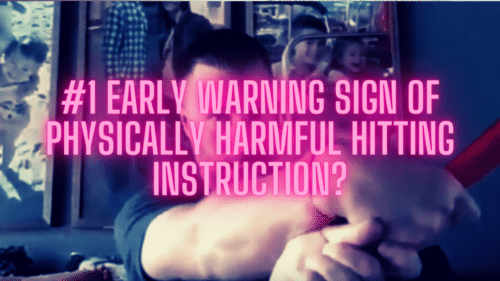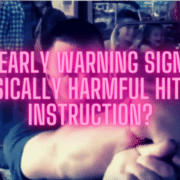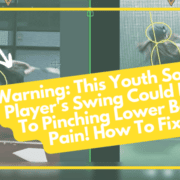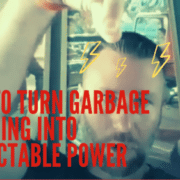Do You Recognize The #1 Early Warning Sign Of Physically Harmful Hitting Instruction?
Jaime Cevallos Part-3 Interview: How to Turn Harmful Instruction into Safe & Effective
In case you missed any of the 3-part series…
- Part 1 – How To Turn Garbage Teaching Into Predictable Power
- Part 2 – How To Wind Up The Body To Deliver More Force
- Part 3 – [You Are Here] Do You Recognize The #1 Early Warning Sign Of Physically Harmful Hitting Instruction?
Here’s what we’re going to discuss in Part-3 of the Jaime Cevallos interview:
- To show the numbers or not to show the numbers?
- What about hand path? What would you say about that?
- Wrist snap: supinating snap or pronating snap? And,
- Why ‘barrel moves body’ approach is wearing holes in low backs.
The following is the transcription of the above video. You can find Jaime Cevallos at the following places:
- Website: https://www.theswingmechanic.com/
- Twitter: @jaimecevallos
- Instagram: https://www.instagram.com/the_swing_mechanic/
- YouTube: https://www.youtube.com/user/cevallos1012
Enjoy!
To Show the Numbers or Not to Show the Numbers?
Joey Myers 00:05
…left field, right? Righties are always going to be showing their numbers more than lefties but it’s only because of the angle. If you see a lefty really showing his numbers like Robinson Cano… legit like him and Trout are probably pretty equal and how much of the numbers that they show. They say it takes the eyes off the ball, and then they call it false separation.
Joey Myers 00:29
They say you’re moving away from contact. And I’m like, well, they obviously don’t know how the human movement like looking basic locomotion, right? Because it’s all about spirals. It’s all about rotation, pre-loading the torso before you get to landing that’s what it’s all about. That’s how you take the slack out.
Joey Myers 00:46
And the other thing is, after they started to soften to it some of these guys that were teaching the guys, some of the stuff we’ve been talking about the philosophy, the barrel moving the body. After a while then it was like okay, well I see guys doing that I see guys showing their numbers but they can’t get to an inside pit like 97 in like that.
Joey Myers 01:06
So I went online I looked up Craig Hyatt’s page, I looked up videos of all those guys we mentioned in this video so far maybe and all these guys and I was looking for 95 plus inside and was trying to see because one of my hitters actually this was about three years ago. Hitter’s been with me since he was seven, he’s now driving, he’s got his license, he’s 16 now he’s pretty clean Catapult Loading System wise, like the stuff we’re talking about today.
Joey Myers 01:31
And he was having a hard time and I was teaching that deep barrel dump, that barrel in the zone super early, no matter if the balls in middle or away didn’t matter, barrel dump. We were throwing live and I’m throwing to him and he’s like, coach, I don’t feel like I can get to that inside pitch. He goes, am I showing my showing my numbers too much. I was like, ah, I don’t think so. But let me do some research.
Joey Myers 01:50
I went to Craig Hyatt’s page. I was looking at 95 plus inside. I was looking at those specific hitters that do this, where there’s a lot of them doesn’t take long to find them. On pitches that were fastball that hard inside, were they, the question was, were they still showing their numbers or showing their numbers less than if they would on an outside pitch? And the answer that came up was clear as day, was that they showed their numbers the same regardless of the pitch. It’s not something like a stride…
Jaime Cevallos 02:20
Showing numbers happens before you know where the pitch is.
Joey Myers 02:23
Yeah, yeah! You can’t like, adjust on the fly, right? You’re just loading your body and getting ready. That answered my question. I was like, okay, these guys that are saying, “Well, you can’t do it, inside, 97 in.” It was like, Okay, well, what, what’s the difference then. And what I’m going to reveal, this is a talk for another video, probably would have to go into this one.
Joey Myers 02:48
The difference was when the barrel entered the zone. If the ball was in, middle, inner third. What they did was they tucked the barrel closer to their shoulder…up, up, up, up, up, up… and then what we call the belly button catcher’s glove, they release the barrel… Imagine a catcher in line with the hitter’s belly button. If they release their barrel in line with the hitter’s belly button catcher’s belly, but like they’re knocking the catcher’s glove off that’s in line with the hitter’s belly button. Right?
Joey Myers 03:19
Barry Bond swings… A lot of times, he would hit pitches that seem to be like right here, and he frickin hit him into the, into the bay. Right? And he couldn’t do that. If he’s dumping his barrel early. It’s not going to happen.
Joey Myers 03:35
So that was what I found out again, that’s a talk for probably for another video. But that was what I found out. It wasn’t about showing numbers. There was no, all the objections they were raising, well, it pulls the hitters eyes off the ball. No, not if you use the head as an anchor. You know, you can’t hit 97 in like that. Well, no, we see them hitting 97 like that, but it’s something else. You’re not, what is in the way of view accepting this is we’re talking about something totally different has nothing to do with showing numbers.
Joey Myers 04:05
You can’t disagree that they don’t show their numbers. I mean, it’s right there clear is day, and their video, they’re big on video analysis and that’s what’s silly that’s what’s clownish about the whole thing.
Jaime Cevallos 04:17
What about a hand path? You could do all what you’re asking a hitter to do but then you could have the bar arm, the arm the front arm barred or you could come in like this. What would you say about that?
What about Hand Path? What would you say about that?
Joey Myers 04:46
So you got, again, the swing is a journey. It’s not a destination, right? So especially with younger hitters, so I have my hitters right now I don’t work with many that are below unless they’re online, below age 11 or 12. Because we do small private groups and it’s harder for the young ones to work into groups with older guys. Most of my guys are high school going into college and I have a few Junior highers going into high school and stuff like that.
Joey Myers 05:11
So the younger ones that tend to have a harder time with it, especially the ones you’re talking about that are very linear with their hands, they’re going here. And I have one right now who’s actually a junior in high school. He’s made huge strides. He was barely able to, he was knocking on the door to 70 miles an hour ball exit speed when he first started with him. This was probably about a year and a half ago, and he’s now at 83. I think he’s topping out off the backspin tee which is pretty impressive because backspin tee takes off about three miles an hour from a Tanner tee.
Joey Myers 05:44
Backspin tee, that’s equivalent to Tanner tees 86. In a game, he’s hitting 86 plus a plus five in a game. He’s hitting 91 in a game pretty good for a junior, right? But the problem we’re having with him and I’m thinking we’ve been doing some movement stuff with the RotexMotion and different things like that. And that’s where his improvements have come. And that’s, by the way, 83 with wood, not bad.
Joey Myers 06:08
And the big problem we’re having with him is that when he turns, we get him into a position where he’s barred out. But like you said, what happens if they bend and they come through this way, and that’s kind of what he’s doing. What we do and this takes a little bit of time, at least from my understanding, we’re doing what’s called a wrist snap, a deep tee wrist snap.
Wrist Snap: Supinating Snap or Pronating Snap?
Joey Myers 06:31
See if I can even try this on film, you can see what that is. Basically, what a wrist snap, choke up so i don’t hit my computer, so wrist snap would be… See we get into that barred position; you can still hear me Jaime I’m not too far away. You get into that position and then as I’m coming around, so what I’m going to do is, this is the other thing that you see on video, you’ll see the major leaguers, the elite hitters, you’ll see their knob stop at a certain point.
Joey Myers 07:01
And then this snap comes around. Yeah, I’m exaggerating it here. But in high speed, it actually looks like what the guys are doing. The knob has to stop at a certain point. And then we snap it around. Like when you throw a ball, you get that snap with the hand. What do they call it up? Pronating. Not supinating. Like a lot of these guys teach, they talk about supinating this way, right? This is actually pronating this way.
Joey Myers 07:26
Again, I’m exaggerating just because we’re going in slow motion here, but the knob will stop, and then the barrel comes around and pivots. Okay, so a lot of those kids you’re talking about are bend, and then the knob keeps going. And then what they do is they end up pronating, if when we learn how to do this, and that’s what this particular kid is doing, but they do it way out in front.
Joey Myers 07:50
They’ve already hit the ball, palm up, palm down, and then their balls going away and then they’re pronating. Instead of palm up, palm down at contact and then pronating right away like that. Pronation already starts before they even hit the ball. It’s not over though it’s not that we’re not rolling. It doesn’t look like it’s rolling over yet. They’re still here. But then you get that snap at the end like Hank Aaron would do, right?
Joey Myers 08:14
How I teach it is, at first it was imagining you have a red laser here and then coming out of the knob and a green laser coming out of the end here. What you’re doing is you’re replacing red with green, red with green. And if you watch Griffey, Griffey’s a big one, you watch him do it and everything just snaps right through.
Joey Myers 08:36
We evolved the laser part, the laser, they can figure that out. But to get them to physically do it, I found it was a little tough. So then what I tell them is I want them to snap the barrel past their hands. If their hands and their barrel were in a race, I want their barrel to win. And that seems to help, and I’ll change that up, I might say snap, so for some hitters, and this comes to what you’re alluding to the problem is, they’re over rotating their upper half.
Joey Myers 09:06
At contact, they’re in this type of position. Because they’re not taking slack out of the system or they’re not snapping, they’re not making the body move. Or their lower half is over rotated. We have to under rotate, their upper or lower half. So the deep tee snap, what we do is how we set that up, is we have them set up a tee, whether it’s backspin or Tanner, or whatever, we have them set the tee up slightly deeper than they would normally, middle middle of the plate, where the ball is lined up at landing with their front hip.
Joey Myers 09:37
Okay, so normally, if they’re going to hit that, they’re going to try and hit that to the opposite field, because it’s a little deeper on them. But what we challenge them to do in three phases. The first phase, we call it a 1.0 swing. We practice that red laser to green laser. We just have them sit on a chair or a bucket and we just have them practice that motion and practice that motion in a way where the knob stops at their rib-cage, and then they snap it around and switch it. That’s the first phase.
Joey Myers 10:05
Second phase 2.0, where they get to landing position, they get to their landing position create their tension in their neck, in their head, in their Catapult Loaded Position. And then from there, they got their tee setup deep. And then you’d have them snap it and they have to actually pull it, they have to pull it into the, for righties, left side of the cage, lefties right side of the cage, they can’t hit it oppo.
Joey Myers 10:26
They have to be forced to really snap it around. So those players that do this with their hands, they have a hard time with it because at first, they hit soft stuff to the opposite way until they get good, and part of it is getting good at it is a strength thing. We use a lot of heavy bat stuff because they have to learn how to maneuver that snap and be able to control it.
Joey Myers 10:46
And it’s like a pinball machine, the flapper right? If you want to hit a ball, a pinball, to the right side of the table, you got to hit it in a certain position and you got it the directions got to go that way. If you want to pull it You know, same type of thing. The snap is we can, I can practice my snaps to right. I can practice them to center and I can practice them the left. It’s getting familiar with the move, and the hitters that are opposite, they bat left, throw right or bat right, throw left, they’re going have a harder time because now they’re controlling that with their top hand. They’re going to have a hard time in the beginning, but usually takes those hitters about a week more to get it then then the right right or the left left.
Jaime Cevallos 11:29
Okay. I just want to be respectful of your time as well.
Joey Myers 11:35
Yeah, I got a little bit of time if you’re if you’re good, I’m good.
Jaime Cevallos 11:40
I actually don’t have…
Joey Myers 11:43
I’ll be respectful of your time today.
Jaime Cevallos 11:48
But I do want to ask really quick what is the worst thing that’s being taught out there right now, to be on the negative side of things.
Why ‘Barrel Moves the Body’ Approach is Wearing Holes in Low Backs
Joey Myers 12:01
I know there’s so much but you know, to prioritize that, I would say the worst thing is that barrel moves the body because…
Jaime Cevallos 12:08
And that you’re referring to, I believe, teacher man’s teaching where basically he says that this is a really interesting approach and I agree with you, it’s absolutely crazy to think that basically you’re the center of the swing is, is when you snap the barrel back like that. Okay, so that to you is…
Joey Myers 12:38
Here’s, here’s the thing, right? I’m okay with that. Middle away and middle down. I’m okay with that. That barrel entering the zone early is fine, because you’re making contact later in the zone. So again, like my player that got tested, and found out that he was maximizing barrel bat speed behind him, but by the time he got the impact, which was maybe an inside pitch, maybe middle in, maybe middle up. His barrel was slowing down but that time.
Joey Myers 13:04
You can’t teach all hitters to do that all the time because it depends. I like his approach. I love teacher man’s approach. I’m not I’m not trying to put him down. I love his approach middle away, middle down. And if I have a hitter who is a physically swinging down hitter, which I don’t have too many, most of them are barrel dropping type hitters, so we have to go the other way.
Joey Myers 13:27
I like his approach, middle away, middle down, or if the hitter is physically swinging down, like he’s got too short of an approach. I’m good with it. The problem that I have with it is that they’re teaching it to all hitter’s blueprint, blueprinting to all hitters. Regardless of pitch depth: inside, middle or away, it’s the same barrel path all the time doesn’t for one that’s not going to work middle and middle up. Doesn’t work very well. Not very consistently, let me say, consistently.
Joey Myers 13:56
The other thing is I see all these hitters arch their backs. I see them arching their backs in a way that is putting these hitters in harm’s way big time, like, of course, an 11 year old, 12 year old, they’re not going to feel it yet, but by the time they’re our age, they’re going to have a hole in their back, they’re going to have back spasms, herniated discs, all kinds of stuff. If they continue to do that swing after swing after swing after swing.
Joey Myers 14:17
I like the approach but being safe with it, meaning we call it the hollow position, taking your belly button and your belt buckle and pinching those two points together. That puts up more of a flex in the lower back. And if you can hold that flex and do what teacher man’s telling you middle down middle away, it’s a great approach. I love it. But I see too many back arching and turning and at that point, it just makes me want to puke.
Jaime Cevallos 14:47
I think it’s important that we talk about everyone, everyone’s theories of the swing and get it out there basically, I think right now a lot of it is just so hard to understand what exactly the people think, what do people think about the swing. I appreciate you coming on, I think we need to do this more guys who have popular theories about the swing. Come out and explain it. I think this is good. I would love to ask you more questions, but we filled up the time already. Let me give you a chance to tell people where they can find you.
“Where can People Find you?”
Joey Myers 15:46
Sure. Thanks, Jamie. I appreciate the time and we’ll do a part 2, 3, 4 whatever. But people can find me HittingPerformanceLab.com, you can go. There’s a lot information 300+ blog posts been doing that since like 2014 I think is when I came out with the blog, there’s a lot there use the search bar the top for whenever you have a query. I have it all in the navigation bar separated by popular blog posts and then I have it by blog posts that have to do it build more power, hit more line drives, get on time more often and then I have other blog posts in there too.
Joey Myers 16:20
That can help to filter the information so you can find out what you need. And then the other part and you can find me on the socials, either Joey Myers just type in “Joey Myers” or “hitting performance lab” and you can find me there on Twitter, Facebook, LinkedIn be Joey Myers and Instagram.
Joey Myers 16:38
I’m going to be doing some different stuff here in the next probably couple weeks I’m going to change around what I’m doing to make it a little bit more user friendly. So that’s where you can find me and then TheStartingLineupStore.com is where I have the… It started off as the nine best hitting aids on the planet but you know there’s a little bit more than nine so I couldn’t stick to that but it is the hitting aides that I use and others use and things like that. So HittingPerformanceLab.com in TheStartingLineupStore.com.
Jaime Cevallos 17:06
Awesome. Thank you so much, Joey. And till next time take care, buddy.
Joey Myers 17:10
Got it bud thank you.
Jaime Cevallos 17:12
All right.
- Fix Late Swings Fast: 2025 Pitch Recognition & See-Decide-Swing Training for Youth Baseball Power Hitters - October 6, 2025
- Safe Youth Weighted Bat Training: Proven Overload/Underload Drills to Increase Exit Velocity in Games Starting Tonight - September 29, 2025
- AI Coaching Course 2025: Youth Baseball & Softball Practice Plan + Off-Season & In-Season Workout Builder Fast - September 23, 2025













As always, useful, applicable, great info. Great series. Definitely in the library.
Thank you Bill! Glad to help